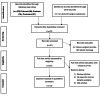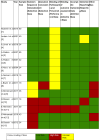A Systematic Review of the Learning Curves of Novices and Trainees to Achieve Proficiency in Laparoscopic Skills: Virtual Reality Simulator Versus Box Trainer
- PMID: 39628757
- PMCID: PMC11614029
- DOI: 10.7759/cureus.72923
A Systematic Review of the Learning Curves of Novices and Trainees to Achieve Proficiency in Laparoscopic Skills: Virtual Reality Simulator Versus Box Trainer
Abstract
Laparoscopic surgery, established in the 1980s, has become a primary treatment method across various surgical specialities due to its advantages over open surgery, including shorter recovery times and fewer complications. Mastery of laparoscopic skills is essential for novice and junior trainees, who must develop hand-eye coordination, depth perception, and instrument handling. This systematic review examines the learning curves of novices using box trainers compared to those using virtual reality (VR) simulators to attain proficiency in laparoscopic skills. The learning curves are assessed through metrics such as the Objective Structured Assessment of Technical Skills (OSATS), the Global Operative Assessment of Laparoscopic Skills (GOALS), and the Global Rating Scale (GRS) based on the time taken to complete specific tasks. A systematic review was conducted to examine the learning curves of novices in achieving proficiency in laparoscopic skills. An extensive literature search on PubMed, Embase, and Cochrane was conducted using keywords like laparoscopic surgery, minimally invasive surgery (MIS), virtual reality (VR), box trainers, and simulation. Thirteen articles were reviewed and analysed in this study. The analysis of data from these papers, along with subsequent meta-analyses, revealed no significant differences in the learning curves of trainees using VR simulators compared to those using box trainers. Variability in conclusions among studies arose from differences in assessment methods and parameters. Overall, there is no consensus on which training modality yields a steeper learning curve. The systematic review and meta-analysis of 13 studies concluded that there was no notable difference in the learning curves of trainees using VR simulators compared to those using box trainers. It suggests the need for standardized assessment methods and parameters across studies. Generally, box trainers are preferred for mastering core laparoscopic skills like knot tying and suturing, while VR simulators are more effective for teaching specific surgical procedures, such as cholecystectomy and hemicolectomy.
Keywords: box trainers; laparoscopic simulator; laparoscopic skills; simulation trainer; virtual reality (vr); virtual reality in medical education.
Copyright © 2024, Selva Raj et al.
Conflict of interest statement
Conflicts of interest: In compliance with the ICMJE uniform disclosure form, all authors declare the following: Payment/services info: All authors have declared that no financial support was received from any organization for the submitted work. Financial relationships: All authors have declared that they have no financial relationships at present or within the previous three years with any organizations that might have an interest in the submitted work. Other relationships: All authors have declared that there are no other relationships or activities that could appear to have influenced the submitted work.
Figures





Similar articles
-
Effectiveness of laparoscopic computer simulator versus usage of box trainer for endoscopic surgery training of novices.J Surg Educ. 2011 Jul-Aug;68(4):282-9. doi: 10.1016/j.jsurg.2011.02.007. Epub 2011 May 4. J Surg Educ. 2011. PMID: 21708364 Clinical Trial.
-
Comparing Learning Outcomes of Virtual Reality (VR) Simulators Using Haptic Feedback Versus Box Trainer (BT) in Laparoscopic Training: A Systematic Review and Meta-Analysis.Cureus. 2025 Feb 12;17(2):e78910. doi: 10.7759/cureus.78910. eCollection 2025 Feb. Cureus. 2025. PMID: 40091919 Free PMC article. Review.
-
Box- or Virtual-Reality Trainer: Which Tool Results in Better Transfer of Laparoscopic Basic Skills?-A Prospective Randomized Trial.J Surg Educ. 2017 Jul-Aug;74(4):724-735. doi: 10.1016/j.jsurg.2016.12.009. Epub 2017 Jan 13. J Surg Educ. 2017. PMID: 28089473 Clinical Trial.
-
Proficiency training on a virtual reality robotic surgical skills curriculum.Surg Endosc. 2014 Dec;28(12):3343-8. doi: 10.1007/s00464-014-3624-5. Epub 2014 Jun 20. Surg Endosc. 2014. PMID: 24946742 Clinical Trial.
-
Ergonomics in Laparoscopic Box Training and Virtual Reality (VR) Simulations: A Systematic Review.Cureus. 2024 Dec 20;16(12):e76107. doi: 10.7759/cureus.76107. eCollection 2024 Dec. Cureus. 2024. PMID: 39711938 Free PMC article. Review.
Cited by
-
Role of haptic feedback technologies and novel engineering developments for surgical training and robot-assisted surgery.Front Robot AI. 2025 Jun 4;12:1567955. doi: 10.3389/frobt.2025.1567955. eCollection 2025. Front Robot AI. 2025. PMID: 40534772 Free PMC article. Review.
References
-
- Laparoscopic virtual reality simulator and box trainer in gynecology. Akdemir A, Sendağ F, Oztekin MK. Int J Gynaecol Obstet. 2014;125:181–185. - PubMed
-
- Prospective randomized controlled trial of laparoscopic trainers for basic laparoscopic skills acquisition. Madan AK, Frantzides CT. https://link.springer.com/article/10.1007/s00464-006-0149-6. Surg Endosc. 2007;21:209–213. - PubMed
-
- Virtual reality training leads to faster adaptation to the novel psychomotor restrictions encountered by laparoscopic surgeons. Jordan JA, Gallagher AG, McGuigan J, McClure N. https://link.springer.com/article/10.1007/s004640000374. Surg Endosc. 2001;15:1080–1084. - PubMed
-
- Validation of the VBLaST pattern cutting task: a learning curve study. Linsk AM, Monden KR, Sankaranarayanan G, et al. https://link.springer.com/article/10.1007/s00464-017-5895-0. Surg Endosc. 2018;32:1990–2002. - PMC - PubMed
-
- Substituting virtual reality trainers for inanimate box trainers does not decrease laparoscopic skills acquisition. Madan AK, Frantzides CT. https://www.ncbi.nlm.nih.gov/pmc/articles/PMC3015783/ JSLS. 2007;11:87–89. - PMC - PubMed
Publication types
LinkOut - more resources
Full Text Sources
